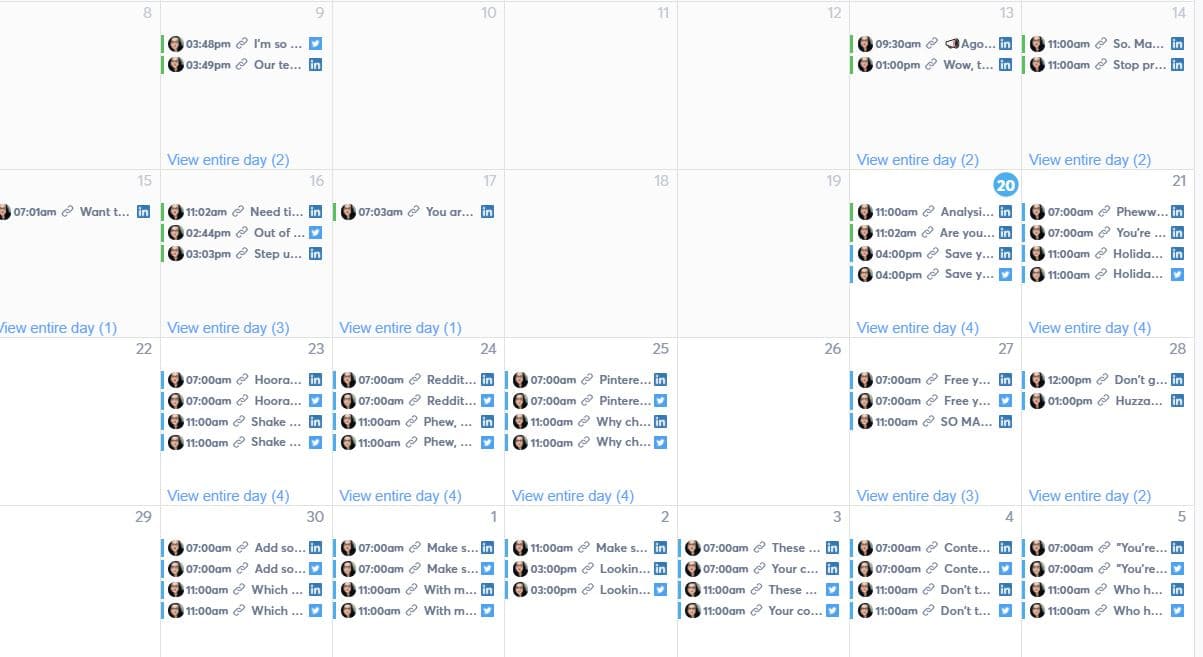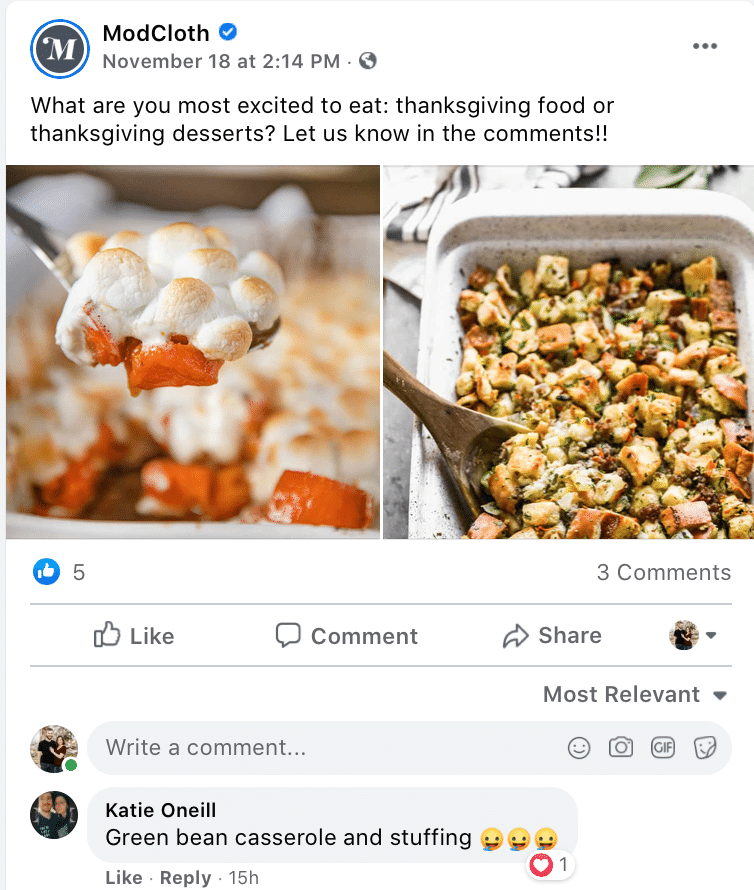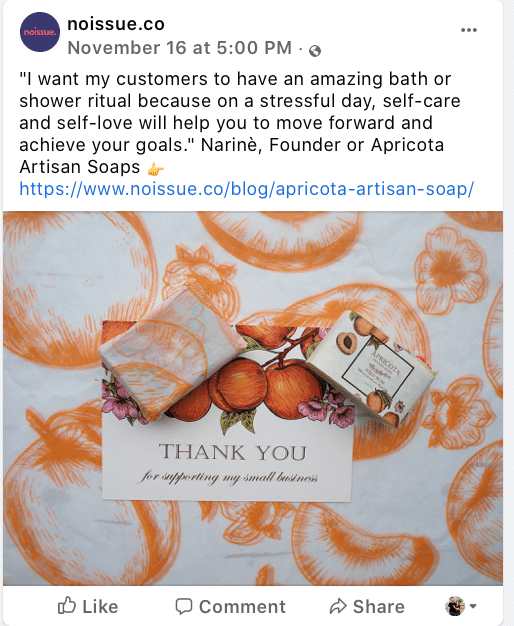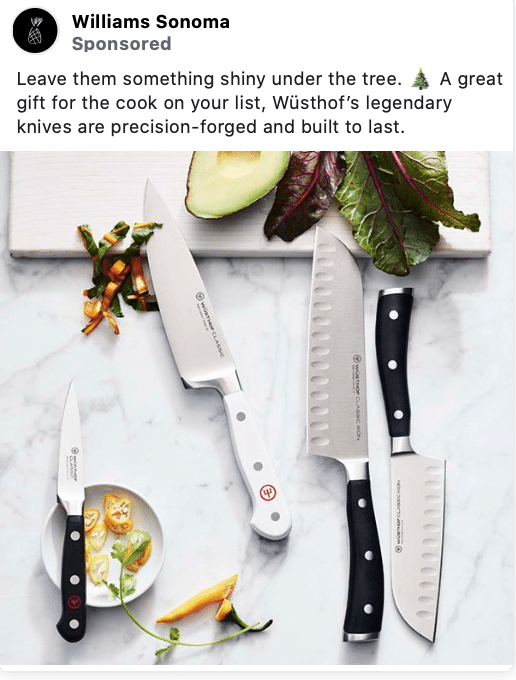Selling on Facebook is different from selling on other social media channels. Especially during the holidays. Check out these tips for excelling at Facebook this time of year.
While Facebook has started out as a Myspace-duplicate platform, with college students sharing their every thought and their relationship status, it’s evolved into so much more. Facebook is now an incredibly powerful selling tool, both when you’re using organic Page sales features and with its ad system.
Knowing how to sell on Facebook, however, is crucial if you want to go beyond building relationships with your followers. It requires a dedicated set of strategies and careful use of the sales-focused features.
There’s no one-size-fits-all solution to social media selling, after all. So if you’re wondering, “How does selling on Facebook work?” keep reading: We’ve got plenty of tips and strategies to get you results.
In this post, we’ll look at everything you need to know about selling on Facebook, including how to create a strong sales-focused content calendar (you can even grab a free content calendar), different on-platform sales features you can use, and other tips to maximize conversions.
Start With a Strong Content Calendar
A content calendar is an absolute must-have when running a Facebook Page, especially if you want to drive sales. We recommend maintaining one throughout the year with seasonal content, promotions, and products.
Content calendars allow you to map out everything you’ll be posting during a set period (or at least most of it!), including images, videos, and hashtags. This can take a lot of stress out of executing your social media strategy, because you’re not scrambling last minute.
Plan ahead by using a social content calendar.
When you can actually see what is being posted at any given time, you’re much less likely to duplicate content, and you’re unlikely to forget a big promotion.
You’ll also be saving time and your sanity, which (let’s face it) is often at a premium for social media marketers. (Feeling overwhelmed? We’ve got some tips to help you balance your work and personal time.)
You can see ahead of time when your promotions are scheduled to be posted, so you won’t be scrambling at the last minute to put together a choppy status update and photo about those gift baskets that are 20% off TODAY ONLY.
Now that we’ve covered why you should have a calendar, let’s get into choosing one that will work for you and your business.
Set Up Your Content Calendar
There is a process I go through when I actually start filling in my calendar: preparing and scheduling. This may sound like unnecessary work, but it really helps to make sure you’re covering all your bases with your promotions.
Choose a calendar format
As far as scheduling tools go, there are a TON of great ones out there, but I’ve honestly not found one that has a calendar layout like Agorapulse. It allows you to plug in posts and add photos, as well as giving a preview of the photo when you hover over the post.
Example: social media management calendar
You can schedule posts to appear at the exact time and day you want.
You can also set up a queue of evergreen or seasonal content that can fill in any holes that you have in your schedule.
Prepare your sales content calendar
Whenever I create a new calendar for Facebook posts, I first do a little research to see whether there are any relevant holidays (including “holidays” like National Ice Cream Day) or events going on that could tie into any promotions.
And as we’re approaching the holiday season, keep this tip in mind: For the purposes of a holiday calendar, you’ll want to take into consideration Black Friday, Small Business Saturday, Cyber Monday, Christmas, and Hanukkah.
Other potential big sales times could include summer vacations, prom, wedding seasons near you, back-to-school, graduations, and more. This will create the skeleton of your plan.
Next, think about any sales, coupons, or other promotions you want to run over the next few months, and plug those dates in as well. This will allow you to see if any promotions overlap.
For best results, you want to make sure that you incorporate types of content onto your calendar. This keeps your audience engaged.
Example of engagement via social media during the holidays
Making sure that you have at least one post of the following per week or every other week is a good choice:
Behind-the-scenes and/or “how it’s made” content. This can be used to showcase products or brand procedures that help build customer interest, trust, and buyer intent without feeling like they’re being pressured into purchasing.
Promotional content featuring your products. These post are much more direct about being sales-focused. They feature specific products and why they’re great, and encourage customers to purchase.
Engagement focused posts, like “Which is better: fried turkeys or roasted?” These posts can link to resources on your site, which can help with relationship-building that leads to longer-term sales.
User-generated content and employee-generated content. This is most effective from a sales perspective when it features your brand’s products in some way.
If you need tips and ideas for social content, download our FREE Social Content Calendar.
Schedule your content a month in advance
Now you’re ready to start filling in Facebook posts on your calendar.
At this point, you probably have ideas as to what you want to post–a one-day promotion, a week-long sale, or a special offer only available for your Facebook fans. Whatever the scheduled posts, make sure you create different types of posts to keep your audience engaged.
When you get to this stage, don’t be afraid to experiment with things, reschedule posts, or change them up.
How to Create a Realistic Social Media Post Schedule
If you find that a coupon doesn’t do so well on a Monday, try posting another one on the following Monday. That’s the great thing about calendars–you can see everything at once, so it’s much easier to shuffle things around so you can improve your results without getting everything out of sorts.
A content calendar is a great first step. Now, you just need to know how to optimize your content for sales.
Let’s take a look at several reliable and highly effective ways you can sell more on Facebook into 2022 and beyond.
Set Up an On-platform Storefront
Facebook allows businesses to set up a virtual storefront on their platform. Users are able to view products right there on Facebook’s site, and they can either checkout on site or head to your site to purchase—whichever you prefer.
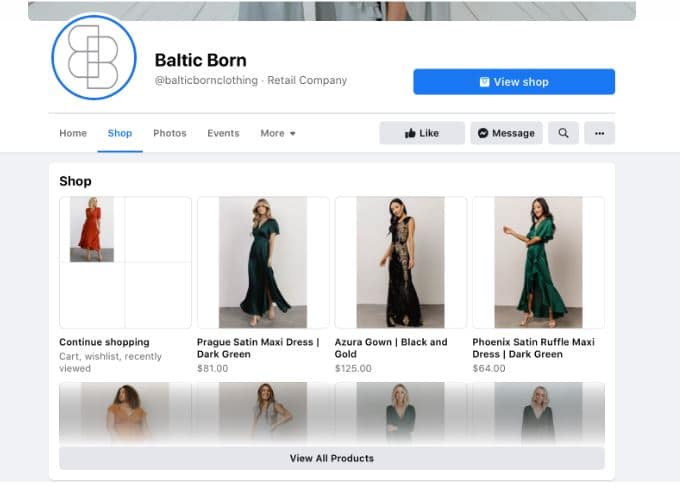 Shops are an outstanding way to sell more on Facebook because they put your products front and center.
Shops are an outstanding way to sell more on Facebook because they put your products front and center.
The added visibility can encourage users to purchase quickly after discovering your brand. And in regards to selling items on Facebook, it’s hard to beat this.
Users can even take advantage of this feature on mobile, which is essential since around 80% of Facebook users only access the platform through their mobile phone.
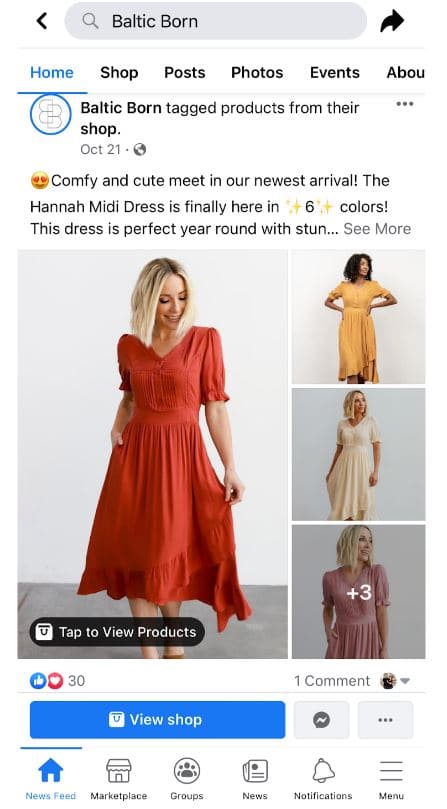
One pro tip: Don’t automatically share tagged Shoppable posts from Instagram directly to Facebook encouraging users to “click to shop.” That Shoppable feature doesn’t carry from one platform to the next and at best will confuse customers (and at worst will frustrate them).
Start a Facebook Group Centered on Your Brand
Facebook Groups are really about relationship building, but that’s also an important part of driving sales long-term. Groups that you create to be centered around your brand can also become immediate and powerful selling tools, especially since their organic reach is exceptional compared to standard Pages.
When people join groups related to your products or services, it means they’re already at least a little invested in your brand. They’re there to learn about inside tips and tricks, to share their experience, and to potentially get exclusive access from the brand.
Here’s a great example: Hamama sells sprout kits, and they’ve got a group for existing customers. Customers share their growing sprouts, the recipes they’re cooking, and their best growing tips. People can ask for help, get information about set up, and even potentially reach out for customer service assistance.
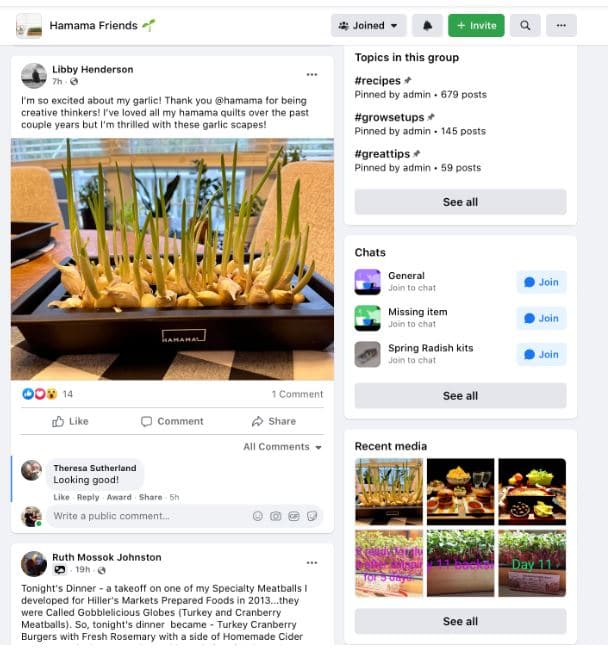
The more invested people become in the group, the more they become invested in the brand. This means they’re more likely to purchase additional sprouting kits for themselves and potentially even for gifts for others.
In addition to long-term brand building, businesses can use Groups to share exclusive coupon codes or beta test offers, promoting their products to an engaged audience that’s highly likely to purchase.
Be Responsive to All Incoming Comments and Messages
Sometimes selling is about getting your products out there and promoting them. Other times, it’s going to be about being ready to help the potential customers who are coming to you.
It’s extremely common for customers to ask questions on public posts, ads, and in private messages. They’ll reach out across Facebook, and Facebook’s sister apps Instagram WhatsApp. It’s important to pay attention to every comment and message you receive, so you can answer questions, overcome objections, and recommend products needed.
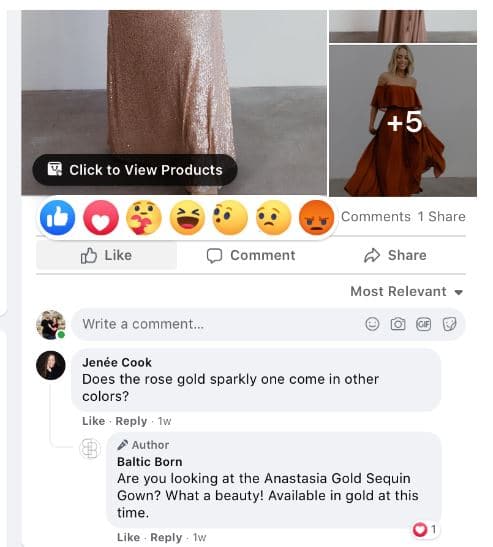
Facebook just released a new feature that allows you to connect your Page to WhatsApp by linking the accounts so customers can message you wherever you choose. Implement that as soon as possible if you’ve got a WhatsApp account.
Manage all your Facebook messages from one dashboard
Leverage Sales-focused Content Marketing on Social
Content marketing can be incredibly powerful as a sales tool when you use it to subtly showcase the products or services that you’re selling. Promoting these posts on social can help expand the reach and attract more sales.
Here’s a great example. Blendtec regularly shares seasonal recipes that requires some blending action. They’ll sometimes share the recipes in a post, but other times, they send the user to a site for a longer recipe.
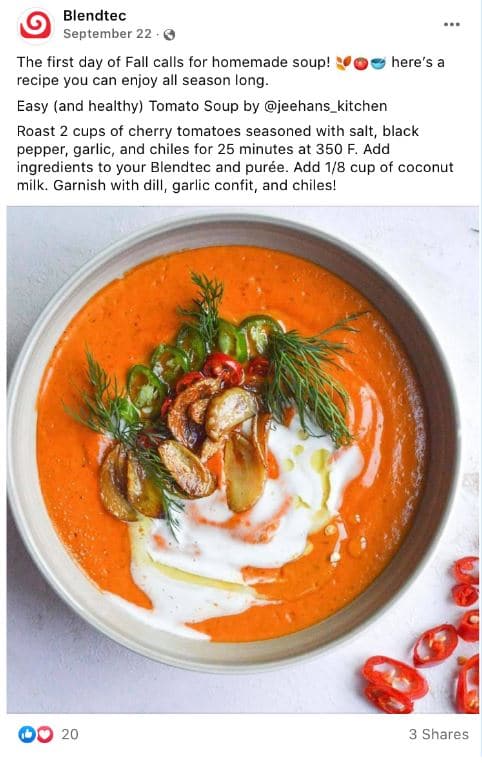
Either way, the strategy is effective: It reminds users that they need a blender, and can get users ready to purchase one, so they can get in the kitchen.
This is a value-based sales tactic, and it can be incredibly impactful on your customers.
Don’t Forget Mobile
An enormous percentage of Facebook’s users are engaging predominantly (or entirely) on mobile: Over 80% of Facebook’s users access the platform almost exclusively through mobile.
This means that your sales-focused content needs to be mobile-friendly.
Let’s look at an example of a post we looked at above and how it translates on mobile.
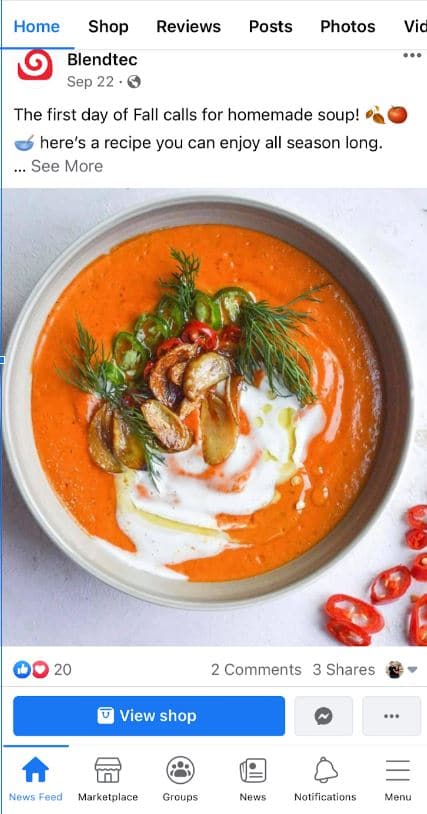
The image still looks great. The recipe’s text is cropped. What Blendtec did well here, however, is they knew how to capture user interest by using an interesting lead sentence (announcing it’s soup season) and then sharing that a recipe is following. Users know what they’ll get and will click to read more, especially with an image that pops on mobile.
Remember that the text of your posts will be cropped on mobile much sooner than on desktop, so you’ll want to put any attention-grabbing content right up front.
Feature Customer Stories and User-generated Content
User-generated content (UGC) is going to be your biggest Facebook selling weapon this holiday season. Customers trust reviews 12x more than marketing coming directly from the brand itself, and two-thirds trust the opinions of other customers posted online.
When users tag you in posts on Facebook or Instagram, ask if you can share them on your own profiles. Tag the user back when you do share it, and add in any positive comments they’ve made. Images and videos are most powerful, but testimonials are great, too.
You can always add a link to the product being featured in order to drive more sales and make it easier for other users to purchase.
Host a Product-focused Giveaway
Contests offering sweepstakes and giveaways are a great way to garner plenty of attention for your brand through user shares and conversation. Getting something for free is hard to pass up, and product-focused contests can generate buyer intent in addition to brand awareness.
You can tell customers they can win a gift card if they do any of the following:
Create a wish list
Share a picture of themselves with one of your products
Come in-store to enter a raffle
All of these actions bring your products to the center of their attention, which can make them think about what they would purchase. Sometimes this is all you need for an extra sale.
You always want your contests to have some sort of social element for maximum visibility. This can help you reach new and existing customers alike.
Don’t Forget Facebook Stories
Instagram Stories typically get all of the attention in social media’s vertical, disappearing-after-24-hours content, but Facebook Stories hold their own, too.
Use Stories to feature UGC, big announcements, and exciting products. You can direct users to view your post or to announce sales, directing them back to your site.
Stories are vertical, mobile-first content, and using a combination of images and short, 5-second or less videos is a great choice. Add text and emojis to make your Story stand out and to drive your point home.
Use Ads to Expand Your Reach & Engage Warm Audiences
While all of the strategies we’ve discussed so far have utilized organic (aka free) marketing, the reality is that if you want to sell a lot this holiday season, it’s always worth at least dipping your toes in the Facebook Ad pond.
Facebook Ads is an exceptional way to reach audiences at all stages of the funnel, but it’s biggest strength lies in reaching new cold audience members. Their incredible machine learning capabilities will automatically assess who responds to your ad, and they’ll optimize your campaigns moving forward based on that information.
In Conclusion
In most cases, I find once you start using a calendar to schedule Facebook posts, it’s really hard to imagine life before it. Visual layouts, the ease of seeing when other promotions correspond with what you’re posting, and the ability to easily move things around really make calendars a great way to manage your social media strategy overall.
* *
Get started on saving time and energy on your own social media management! Check out our free trial of Agorapulse to help you schedule, track, and measure all your social media efforts.
Read more: agorapulse.com




